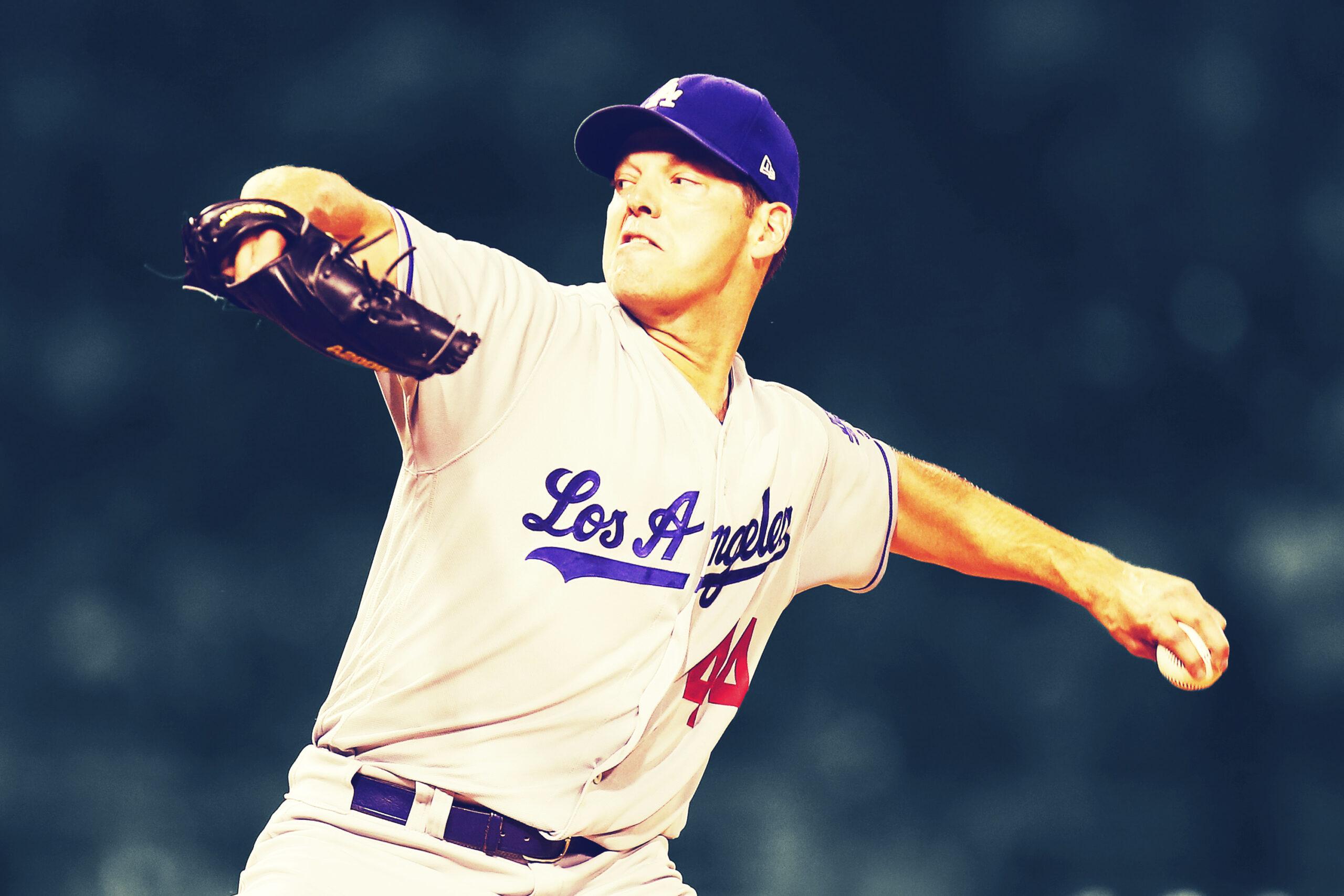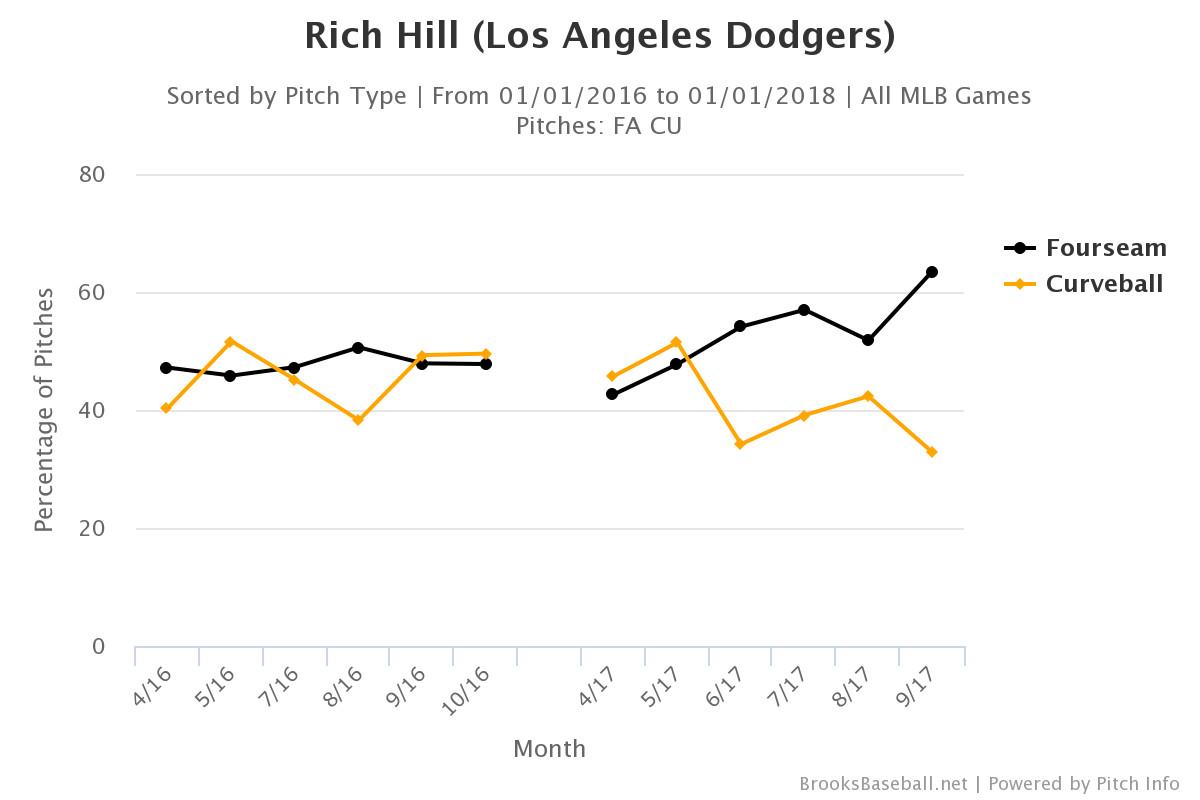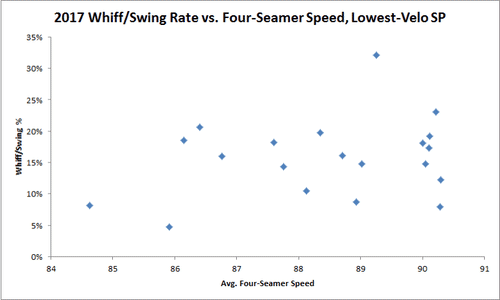
After two years of enthusiastic retellings by baseball media members, most fans are familiar with the six-figures-to-eight-figures origin story of pitcher/folk hero Rich Hill, the 37-year-old lefty slated to start for the Dodgers against the Diamondbacks in Saturday’s NLDS Game 2. Hill, who broke into the big leagues with the Cubs in 2005, managed only one full, healthy season in his 20s before spending close to a decade bouncing among the bigs, the disabled list, and lower levels of pro ball amid a series of muscle strains and serious surgeries. Released (as a reliever) by his ninth organization, the Nationals, in the summer of 2015, he signed with the Long Island Ducks of the independent Atlantic League, where his two scoreless starts re-caught the eye of the Red Sox, who’d already signed and released him the previous season. A string of four dominant September starts for the big club in Boston earned Hill a one-year, $6 million lottery ticket with the A’s, which—when the pixie dust didn’t wear off in 2016—led to a three-year, $48 million deal with the Dodgers, who re-signed him last December after acquiring him at the trade deadline.

The key, of course, was Hill’s curveball, an extremely high-spin (and high, period) pitch featuring one of the game’s most potent combinations of side-to-side and up-and-down movement. A conversation with Red Sox director of pitching analysis and development Brian Bannister during Hill’s second stint with the Sox unlocked the pitch’s potential, convincing Hill to rely on it almost as a primary offering rather than a sidekick to his fastball (as tradition dictated). Delivered more regularly and with a variety of speeds, locations, and trajectories, the magic curve and Hill’s Kershawesque per-inning performance sold the Dodgers on the resurgent southpaw despite his short track record of recent success and the blisters that hampered or sidelined him for much of the second half of last season.
Through mid-June of this season, the Dodgers’ investment looked borderline disastrous. Hill’s blister problems recurred, limiting him to eight starts. Even when he was on the mound, his control was way off—perhaps in part because of the blisters, or an attempt to avoid them by adjusting his grip—resulting in 23 walks in 35 innings, with a 5.14 ERA. More dismaying still, Hill’s curveball wasn’t working. As Jeff Sullivan noted on June 16, FanGraphs’ pitch-type stats rated Hill’s curveball, which was among baseball’s best from 2015-16, as the least-valuable curve up to that point of this season, even though the blister sabbatical had cost him more than a month. As Sullivan wrote, “Rich Hill’s world-beating breaking ball has completely abandoned him.” Without that curveball, it looked like little was left: an old, blister-prone pitcher whose already-pedestrian fastball was down a tick or two from 2016, averaging roughly 89 and topping out at about 92.
By the time that post was published, though, Hill had already embarked on another reinvention. When the breaking ball abandoned him, he responded by abandoning the breaking ball.
On June 3 in Milwaukee, Hill threw curveballs “only” 32 percent of the time, down from 52 percent in his previous start. It was his most sparing curveball usage in any start since April 2016. Some of his customary curves were displaced by a cutter/slider Hill had developed with the assistance of one Clayton Edward Kershaw, who’s been known to throw the occasional slider himself. “It’s something different,” Dodgers manager Dave Roberts said at the time. “The book on [Hill] is fastball, curveball. Add a little something for those guys to think about.” After an initial flurry of cutter/sliders, though, hitters haven’t had to think about it much; Hill has all but retired the new pitch, at least according to Pitch Info classifications provided by Baseball Prospectus director of technology Harry Pavlidis. Not every experiment sticks, but Hill is always willing to tinker to stay one step ahead.
His next time out, on June 9, Hill made clear what would take the place of those missing curves for the long haul: fastballs. Facing Cincinnati, he threw 65 four-seamers, by far the most he’d delivered in any start since his Bannister-driven salvation.
That trend toward the heater has held up since. Here are Hill’s month-by-month curveball and four-seamer rates since the start of 2016:

Throughout 2016 and the first two months of this season, Hill’s curveball usage usually kept pace with or outpaced his fastball. Since June, though, the heater has outstripped the curve, and the gap was wider than ever in the past month. In Hill’s last two starts of the regular season, he threw fastballs 69 percent and 67 percent of the time, respectively. Both of those rates surpassed his pre-September high.
So how has Hill fared while tying his fortunes to a fastball that’s averaged 89.3 since he started cutting back on the curve? We’re talking about Rich Hill here—the man, the myth, the legend—so naturally he’s been one of the best pitchers in baseball.
Since Sullivan’s post about Hill’s problem breaking ball, Hill has made 17 starts—including an almost-perfecto—posting a 2.68 ERA, holding opposing hitters to a .185/.249/.340 slash line, and recording 131 strikeouts in 100 2/3 innings, with 26 walks. Among pitchers with at least 75 innings pitched over that span, only Chris Sale, Corey Kluber, and Max Scherzer posted higher strikeout rates, and only Kluber, Stephen Strasburg, and James Paxton allowed lower weighted on-base averages. Hill put on this dominant display while ranking right below Phil Hughes (74 ERA+ since the start of 2016) and Matt Cain (75, and just retired) on the full-season fastball velocity leaderboard.
It’s hard to understand how Hill can throw a fastball so slow and so often and still induce so many whiffs. The scatter plot in the GIF below shows the average four-seamer speeds and four-seamer whiffs-per-swing rates for the 20 lowest-velocity starters who’ve thrown at least 200 four-seamers this season. You can guess which one is Hill even before his headshot appears.

Only one starter this season has a higher whiffs/swing rate with his four-seamer than Hill does: Jacob deGrom, whose fastball averages 96. Hill, again, averages 89, and, if anything, his subpar extension makes his pitches look slightly slower, but no one would know that from looking at outcomes alone. Brooks Baseball offers an option to express pitchers’ stats on the 20-80 scouting scale, where 20 represents an extremely low value and 80 represents an extremely high one. Hill’s fastball speed since his change of approach in early June registers as a 38—not surprising, since we know it’s on the slow side. His fastball whiffs/swing rate over the same span, meanwhile, registers as an 85. Hill literally breaks the scale.
In the second half of the season, only Justin Verlander and James Paxton, both of whom sit at 96 mph, had higher-value fastballs than Hill (in Paxton’s case, barely). In part, that’s because only five qualified second-half starters threw fastballs at a higher rate than Hill, but even on a per-pitch basis, Hill ranks third in second-half fastball value (behind Verlander and Kluber) among pitchers who threw four-seamers at least 10 percent of the time. In his final playoff tune-up on September 27, Hill struck out 10 hitters, all on non-breaking balls. Sure, all of those hitters played for the Padres, but that wasn’t an isolated event.
Although Hill’s fastball is slow, it’s far from flat. Pitchers who get good spin on one pitch type tend to get good spin on others, and, sure enough, Hill’s heater moves; of 192 starters with at least 200 four-seamers thrown this year, only six can boast more combined horizontal and vertical movement. Throw in variations in speed and release point, and it makes sense that radar readings alone can’t capture Hill’s fastball effectiveness.
Granted, there’s more at work here than just the switch to the fastball. Early in the season, as Sullivan documented, Hill was frequently leaving both fastballs and curves up and away, leading to too many walks and fly balls. In response to that wildness, he worked with the Dodgers to simplify his delivery and stick to a more consistent arm slot, bringing his mechanics back into line. As a result, Hill’s curveball has bounced back, becoming a weapon once more—just more of a complementary one, as opposed to a primary pitch.
Even though Hill isn’t using his bender as often, he’s deploying it judiciously. Compared with last year, Hill has been a lot less likely to go back-to-back with the curve. But he’s still throwing curves almost as often as ever immediately before and after fastballs, as indicated by the sequencing breakdown below.
Rich Hill Sequencing Breakdown
Hill’s frequent fastball-breaking-ball alternation gives him the third-largest average differential in flight time from one pitch to the next. A big part of pitching is changing speeds, and Hill, who toggles between two pitches separated by roughly 15 miles per hour, is the archetypal speed-changer. Because batters know the curve could be coming, they can’t fixate on the fastball.
In time, hitters may notice Hill’s evolving pitch selection and guess fastball more often. (Arizona’s advance scouts have surely picked up on the pattern.) If so, his recent approach might stop working so well. All else being equal, though, a Hill who fastballs may be a better bet than a Hill who curves. Hill’s blister problems were very likely related to his uniquely prolific breaking ball, and his newfound love for the fastball could be reducing the risk of recurrence; he hasn’t had any publicly reported blister issues since he eased up on the curve. If anything, adjusting his pitch mix may have been the best way for Hill to preserve his health for the most important part of the season—and even better, he hasn’t had to sacrifice much from a performance perspective in exchange for added durability.
To recap: Rich Hill, a pitcher with one of the best curveballs in baseball, has increasingly relied on one of the game’s slowest fastballs. And because he’s Rich Hill, he’s thrived regardless, vaulting into an even higher realm of implausibility than the one where he already dwelled. When I asked Pavlidis how Hill is pulling this off, he responded, “Generations of analysts will struggle to understand him.” The Dodgers are hoping that their playoff opponents will, too.
Thanks to Jeff Long of Baseball Prospectus and listener Michael Zadra for research assistance.

